




Contents
Greetings from the 2025-26 Head Boy Team - Felix W, Year 12
Art Show 2025
Marcos Burnett Photography Competition 2025
Roots - George L, Year 12
Lower School Enrichment
Trip to London’s Baker Street Underground Station - Yunus A, Year 7
History Trip to Kenilworth Castle - Minh B, Year 10
Hampton Court - Alex W-P, Year 8
My Away Games Experiences 2024-25 Season with Fulham FC - Henry C, Year 7
Sumo Wrestling: More Than Just Big Guys Pushing Each Other - Thomas C, Year 9
How Wetherby’s Track Team is Coming Along - Luke T, Year 10
Wetherby’s Music Tour 2025Felix W, Year 12
Our Trip To Chessington World of Adventures - Brady F, Year 7
Dungeons and Dragons ClubCharlie D, Year 12
Why You Should Try Modern Board Games - Dylan S, Year
Marylebone Lunch SpotsFelipe E, Year 10
Cheese - BenG G, Year 9
UK Chess Challenge Megafinal - Daniel L, Year 12
Cover photograph - Arthur M, Year 13
Contributing to the Barometer is a great way to earn gold notes, improve your writing, and it looks great on your CV
To submit articles or cover photos, join the Barometer club at Friday lunchtimes (B11) Or, you can email Mr s Bradley at nicola.bradley @wetherbysenior.co.uk
Read the latest issue at https://issuu.com/wetherbysenior
Felix W, Year 12 writes...
In September 2012, a small, timid and very curious boy in shorts and a grey blazer with red piping walked through the red door of Wetherby Pre-Prep in Pembridge Square for the first time. Today, thirteen years later, that same, now much taller and lankier boy is thrilled to be taking over Head Boy duties for the upcoming academic year from Oscar. Having been in the Wetherby family for so long, it feels surreal to go from the induction day of Reception in the basement of the Pre-Prep in Notting Hill to leading the prefect team in Bulstrode.
In the past few months, many of the Year 12s have been lucky enough to become probationary prefects, carrying out all of the usual duties during the morning and lunch slots. The prefect team assists with a wide range of responsibilities — everything from lunch queue organisation to SPRAS supervision; Paddington Street Gardens chaperoning to morning greeting, and many more. It is my absolute privilege to lead them, along with my two Deputy Head Boys: Aditya and Daniel.
At the end of this term, many of us applied for a senior prefect role, and after a highly selective process that included testimonials, letters of intent, and final interviews, the team has been appointed. Now that the appointments are official, you’ll soon get to meet your new Trib prefects and continue to see the rest of the prefect team around the corridors or on duty — so if you recognise us, please do stop
by and say hello!
I’ve really enjoyed my years spent at Wetherby and have always lived by the saying, “Don’t count the time, make the time count.” That attitude is all it takes to thrive at this school, where opportunities are genuinely handed out to students — you just have to be willing to grab them.
Thank you to Oscar, Vangelis, Christos, and the rest of the outgoing Year 13 prefect team, who celebrated the end of a very successful year at their Leavers’ Celebration on Friday. They set a high bar and left us with some clown-sized shoes to fill. The incoming team is energised and looking forward to working together to make the upcoming school year the best yet at Wetherby Senior.

Each year, the annual GCSE and A Level Art Exhibition offers a window into the creative minds of our budding artists, and this year’s showcase proved to be one of the most ambitious and diverse to date. From bold conceptual installations to technically accomplished drawings and imaginative graphic design, the exhibition captured a wide spectrum of artistic voices.
The A Level work this year was defined by bold experimentation and confident execution, with a standout Pop Art installation that echoed the vibrant commercial aesthetic of sixties Pop Art, but with a modern twist — commenting cleverly on influencer culture and digital branding. In stark contrast, a contemporary Cubist sculpture


experimented bravely with fractured geometry.
The GCSE Art section included a series of natural forms sculptures that captured the intricate textures and organic shapes of the natural world. The boys’ My Environment projects showed the scope of their imagination, including a remake of Full Metal Jacket, architectural relief paintings, and mixed media typographic artworks.
The GCSE Graphics students exhibited reimagined book covers showcasing thoughtful typography, symbolic imagery, and professional layout, as well as impressive chocolate box designs that mixed playful branding with careful consideration of packaging structure.
In addition to the stunning visual art on display, this year’s exhibition also featured the highly anticipated Marcos Burnett Photography Competition — a highlight that continues to grow in prestige each year. The competition showcased a wide array of breathtaking photographs, ranging from delicate nature studies to striking urban compositions. The quality and diversity of the entries made judging an incredibly difficult task. After much deliberation, Mr Lawrence awarded prizes to Albert C (Year 9) and Tommy T (Year 13). The overall winner was Arthur M (Year 13).
Thank you to all who attended — we hope you enjoyed the work!
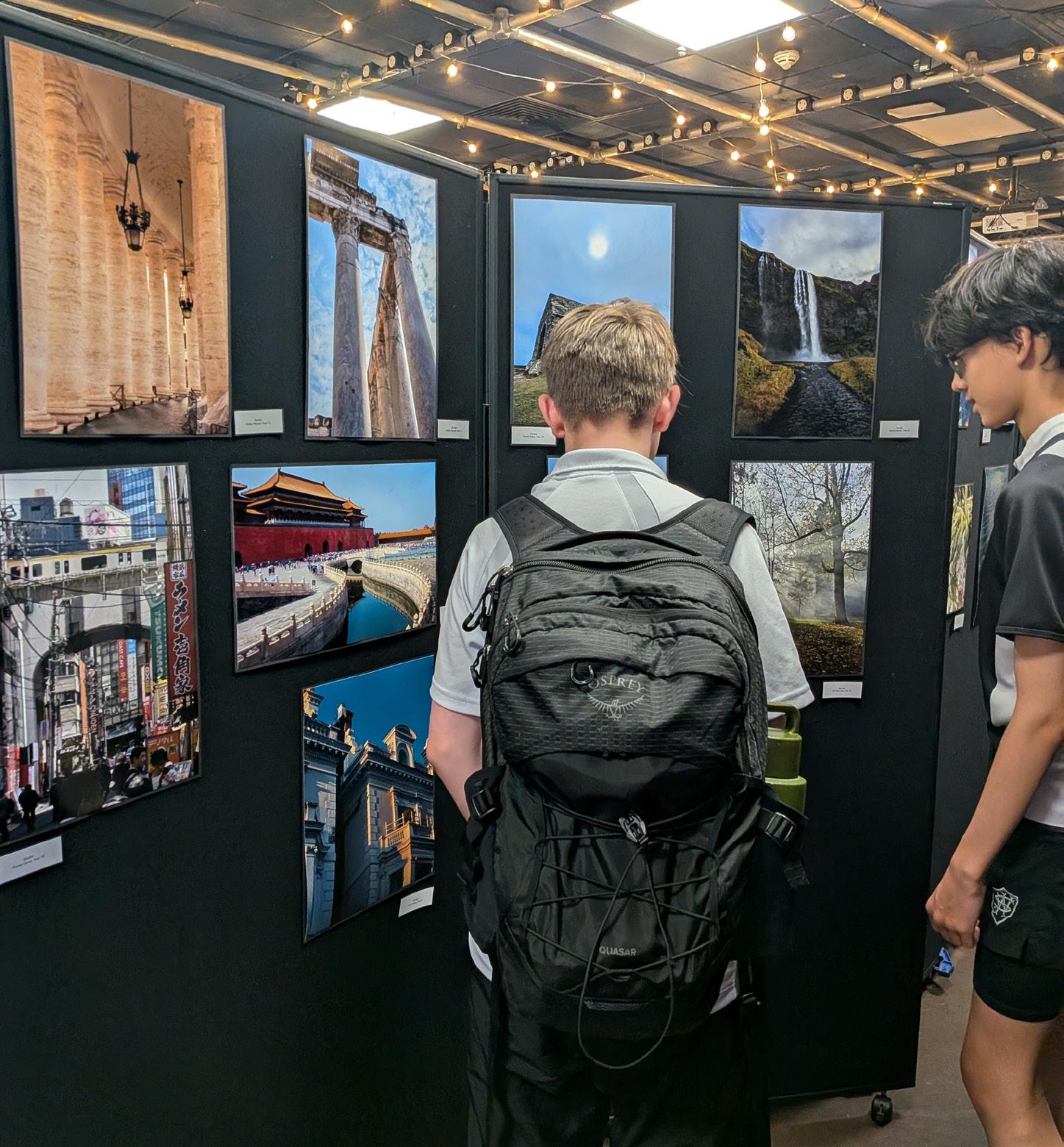



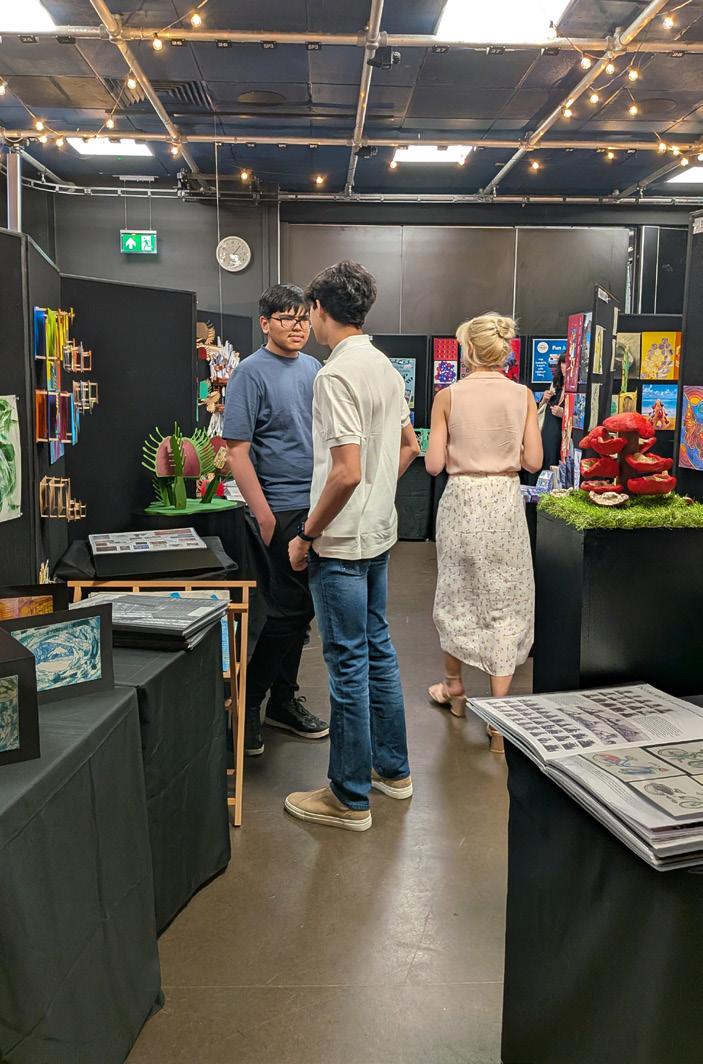



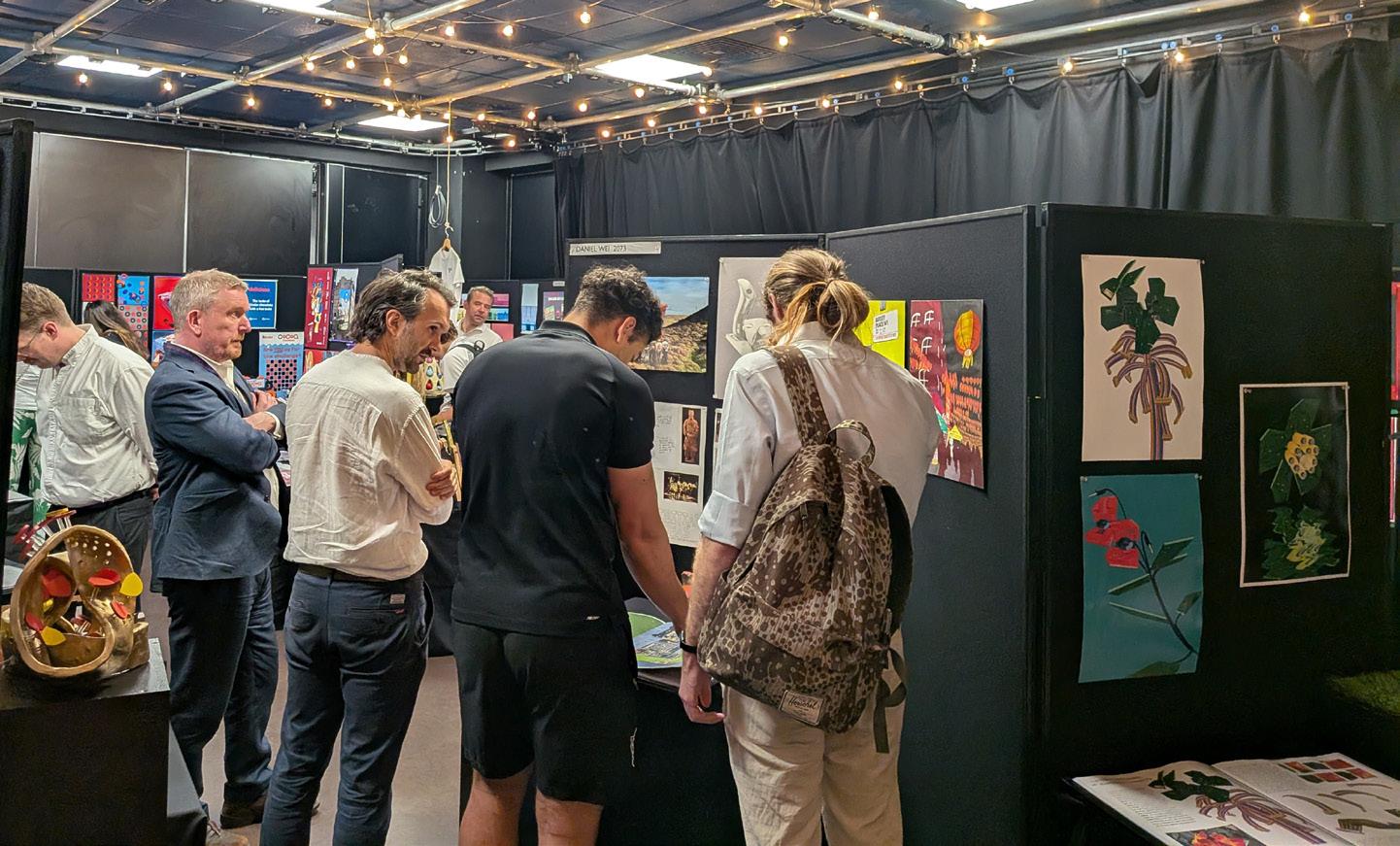
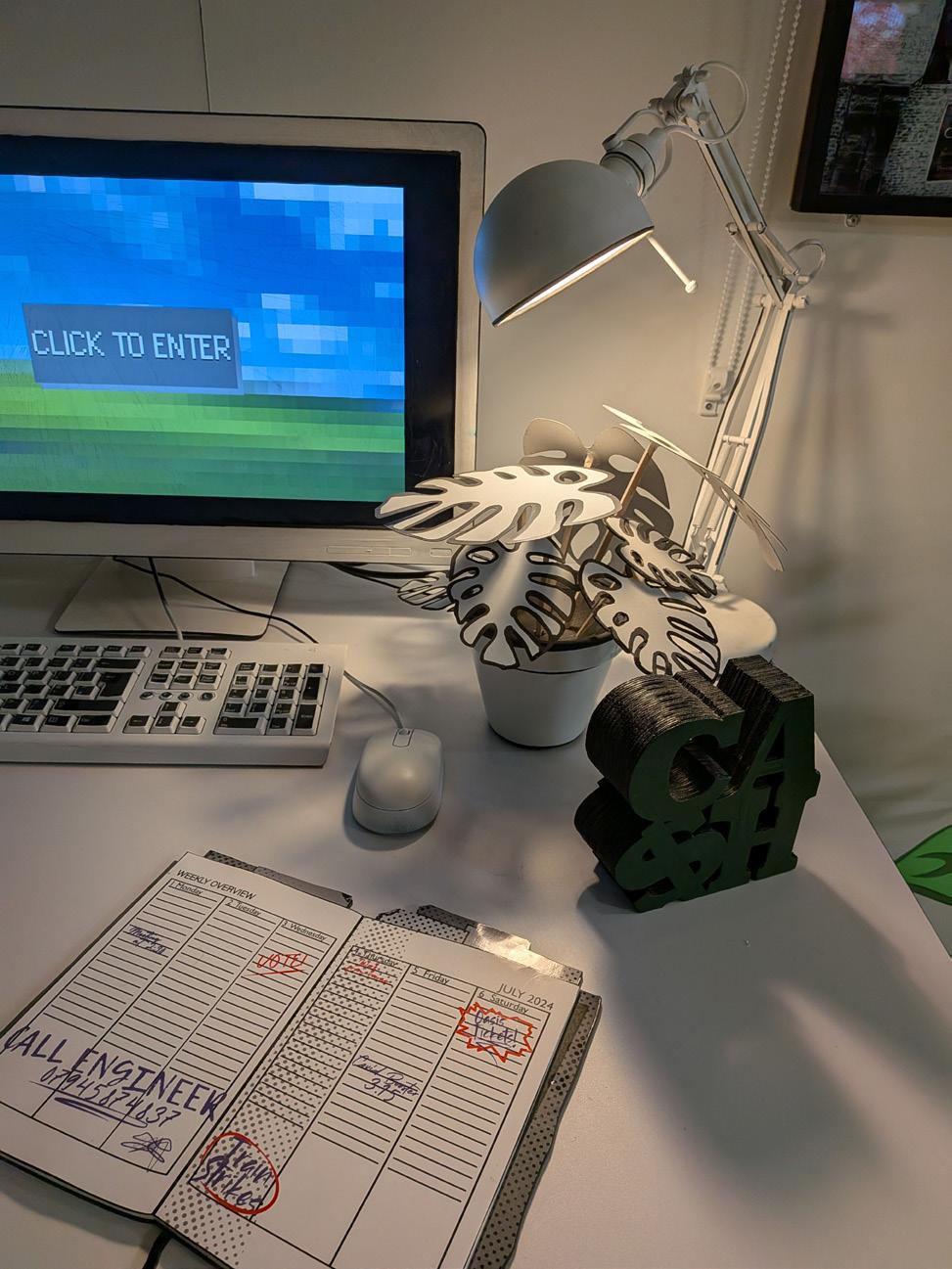



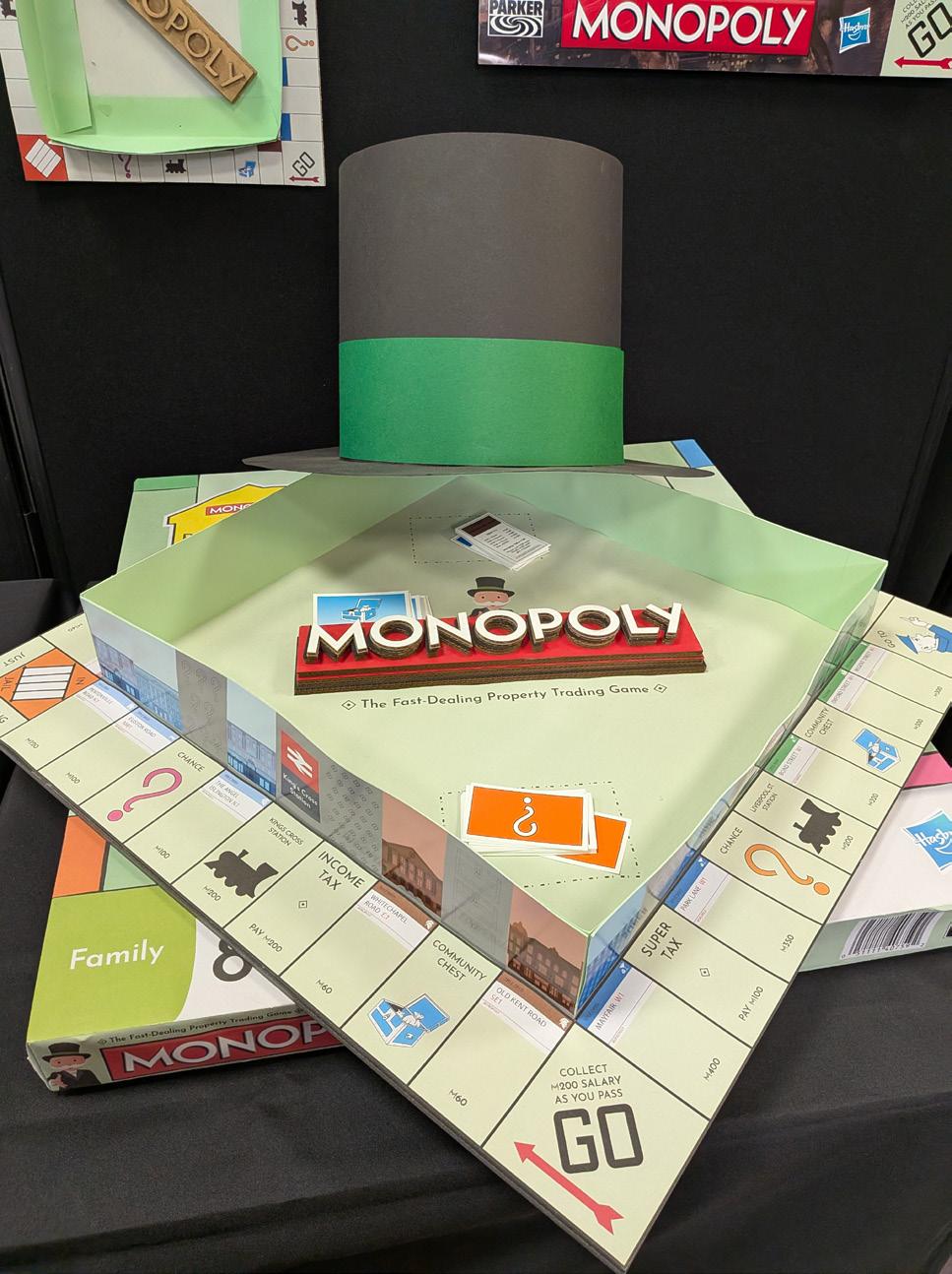


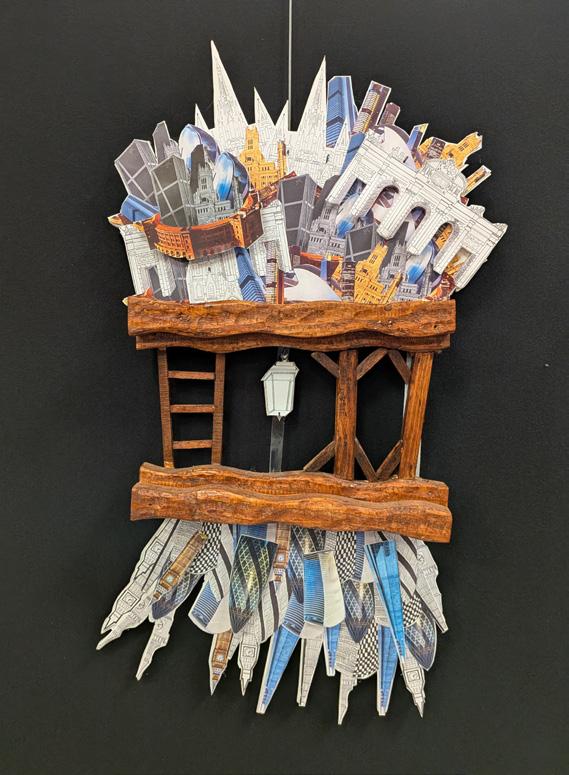


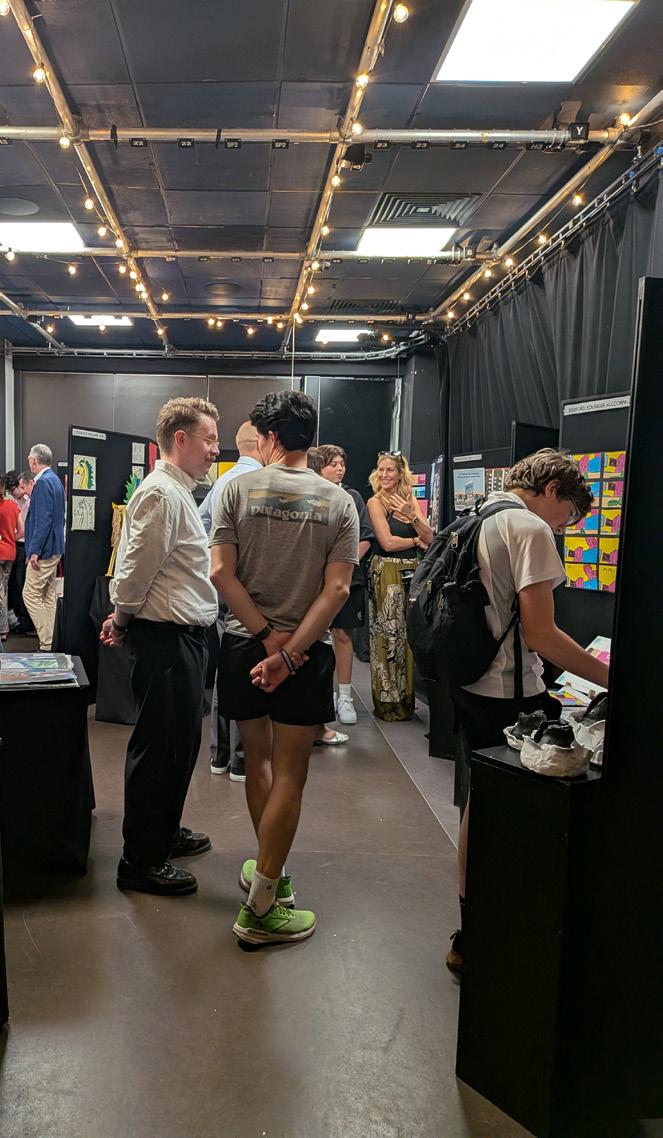




This year’s Marcos Burnett Photography Competition saw a record number of entries, with students submitting an outstanding range of work across themes including nature, architecture, cityscapes, and landscapes. The quality was exceptional, making the judging process both exciting and incredibly tough.
We’re proud to announce that the overall winner of the 2025 competition is Arthur M (Year 13), whose striking image captured both technical skill
and emotional impact. His photograph stood out for its composition, symmetry, and colour, perfectly capturing a unique moment of street photography.
The runners-up were Albert C (Year 9) and Tommy T (Year 13), whose work also demonstrated excellent command of the medium and a strong artistic voice.
The shortlist featured a diverse mix of subjects and styles, showing the depth of talent


across the school. Congratulations to all shortlisted for making it through in such a competitive field.
Facing page, clockwise: Winner: Arthur M (Year 13) Runners-up: Albert C (Year 9), Tommy T (Year 13)
This page, clockwise: Tommy T (Year 13), Ilya S (Year 9), Ari G (Year 8), Arthur M (Year 13)






This page clockwise: Alex W, Year 9, Cezar J, Year 9, Tommy T, Year 13, Giulio D-S, Year 10, Daniel F, Year 10, Theo S, Year 9.
Facing page clockwise: Sam S, Year 10, Arthur M, Year 13, Sho C, Year 8, Sam S, Year 10.
Next page clockwise: Henry C, Year 7, Antonio D, Year 8, Zander J, Year 10, Sho C, Year 8.










George L, Year 12 writes...
On 5 June, twelve Year 12 students, including me, completed the innovative Roots Programme. Now, you might be wondering what the Roots Programme is. Well, and I quote: “A school exchange programme empowering young people from diverse backgrounds in state and independent schools to foster understanding and empathy, celebrating both what they have in common and what makes them different.” We were paired with students from Park Academy to converse on current world affairs such as mental health, culture, community, identity, education, the economy, and much more. Through this experience, I can confidently say that everyone who participated in the programme learned something new and gained valuable insights into their way of thinking.
For the first few weeks of the programme, we had weekly online sessions with the Park Academy students, discussing important topics like Is private school worth

it? or What does it mean to be British?, and generally getting to know each other. We had intense debates and lots of laughs along the way. Despite coming from different educational backgrounds, we quickly discovered that we had more similarities than differences. These early online sessions laid the foundation for mutual respect and created a safe space where everyone felt comfortable expressing their views, even when we disagreed. One of the most memorable discussions was around the question: What does it truly mean to be British? This sparked personal debates among us and helped us learn more about each other.
As the weeks progressed, the Roots Programme shifted from the virtual world to the real one. We finally had the opportunity to meet the Park Academy students in person, and the excitement was enormous. The students from Park Academy first came to our school to learn about and experience school life at a private school. We gave them a tour, and they attended our fourth-period lessons — most of them went to the politics class. Afterwards, they had a Q&A session with Mr Lawrence, where they discussed the challenges of private school and the differences compared to a state school.
Next, it was our turn to visit Park Academy. We began the day with an icebreaker activity before being given a tour of the school. Everyone was surprised by how much bigger it was than ours! Then we had lunch — and we were even more surprised to find we had to pay for our meals. Finally,

we experienced their lessons. I went to a maths class, and, for me personally, the class size was much bigger than expected, though this didn’t affect the quality of teaching at all. We ended the day with a group discussion on the differences between our schools, and we had the chance to ask Mr Mahedy (Deputy Head of Park Academy) some questions about the school, most notably how it had transformed from “requires improvement” to “good” in its Ofsted report.
Our final meeting took place on Thursday, where we met to discuss and finalise our thoughts on important current world issues such as culture, the economy, identity, and healthcare. We created vision statements to propose solutions — for example, giving more funding to the NHS.
Overall, I would recommend this experience to everyone in the school, as it has broadened everyone’s views on current world affairs.
Yunus A, Year 7 writes...
A few weeks ago, a group of teachers and 14 boys took part in a tour of Baker Street station’s inner workings as part of the Lower School enrichment programme.
“It was eye-opening — it was amazing to see the wires and what made Baker Street,” says Amr A, Year 7. The tour included looking at the infrastructure that makes Baker Street one of the most wellknown train stations in London.
This was all part of the Hidden London tour offered by the London Transport Museum, uncovering the secrets of London’s oldest underground station. When Baker Street opened on 10 January 1863 as part of the Metropolitan Railway, it was home to a revolutionary idea: carrying passengers beneath Victorian London’s congested streets. The tour covered Baker Street’s 160year history.
Baker Street: Past, Present, and Future
Baker Street holds a special place in history as one of the first stations of the world’s first underground railway. Today it serves some of the busiest lines in London, including the Jubilee, Metropolitan, Hammersmith & City, Circle, and Bakerloo lines. Regarding Baker Street’s past, it was originally part of the Metropolitan Railway, later adding Bakerloo platforms in 1906 and Jubilee platforms in 1979. Aside from its significance in transportation and London’s history, Baker Street station is also
famous for its reference in the Sherlock Holmes novels written by Sir Arthur Conan Doyle.
Today, Baker Street is not only a major interchange for several lines but, despite being one of the busiest stations on the network, it still holds historical value and handles millions of passenger journeys every year. Although upgraded to modern standards, Baker Street station retains its historic charm with original brickwork and Victorian signage. With ten platforms, Baker Street is one of the most connected stations, linking central London to suburban areas.
What’s next for Baker Street station? With the advancements of
London’s transportation network, Baker Street is expected to see further modernisation, including improvements in efficiency, passenger flow, upgraded signalling systems, and energyefficient lighting. To align with London’s sustainability goals, Baker Street is projected to feature modernised ventilation and ecofriendly infrastructure. Baker Street is part of the Four Lines Modernisation (4LM) project, which aims to improve Circle, District, Hammersmith & City, and Metropolitan line services. From the humble beginnings of steam-powered trains to its modern-day efficiency, Baker Street remains a testament to London’s transportation evolution.

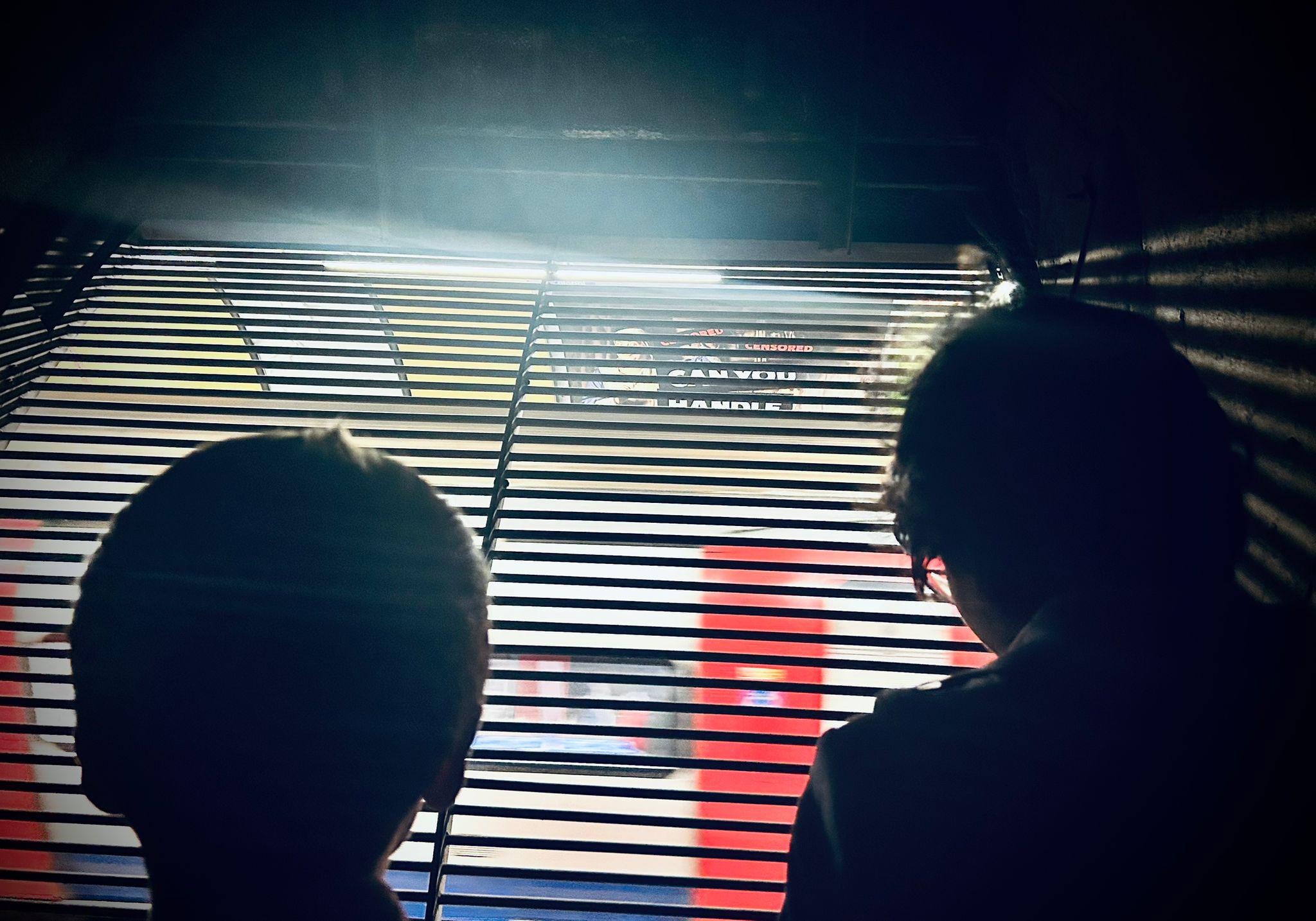

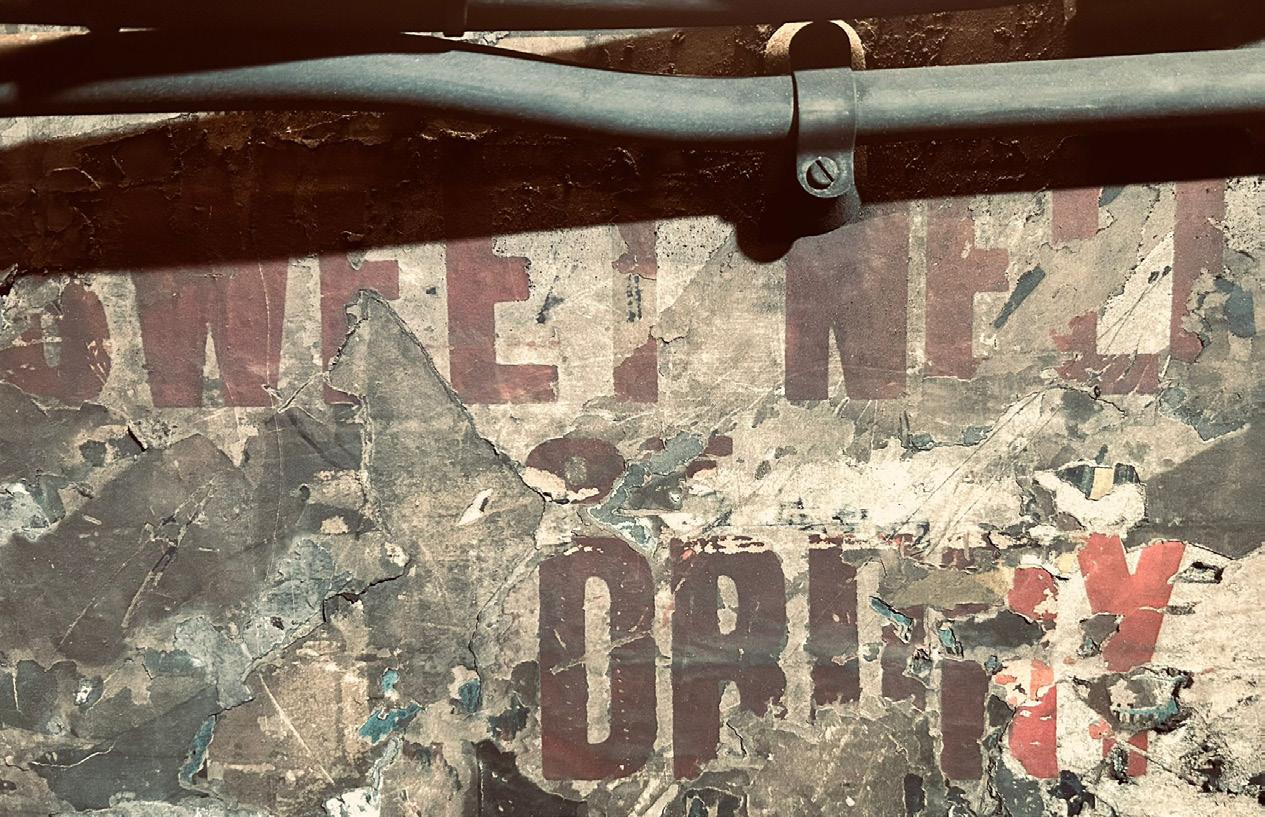
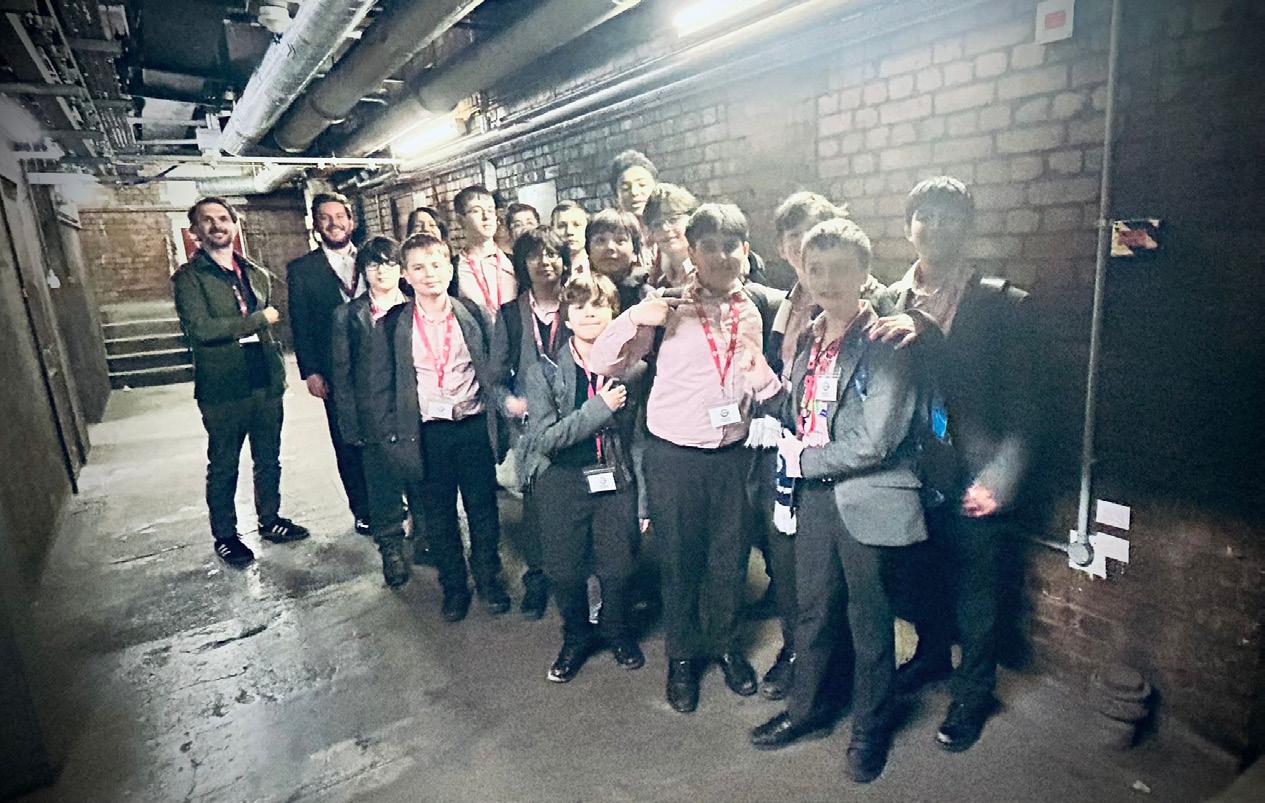

Minh B, Year 10 writes...
Recently, our history class embarked on a much-anticipated trip to Kenilworth Castle, one of England’s most significant and romantic ruins. Nestled in the heart of Warwickshire, the castle’s crumbling walls and majestic towers remind us of its fascinating past. As we approached the site, the sheer scale and presence of the structure were breathtaking, offering a vivid connection far beyond a normal history class on our Surface Pros.
Kenilworth Castle boasts a history that spans over 900 years, originating as a Norman fort in the 1100s. It rose to prominence under John of Gaunt in the 14th century, who transformed it into a lavish palace. Perhaps most famously, the castle played a central role in the Elizabethan era. It was gifted to Robert Dudley by Queen Elizabeth I, and in the 1570s, Dudley hosted her during a royal visit, showering
her with days of feasts and music in an attempt to win her hand in marriage. The visit left a lasting architectural legacy — he added elaborate gardens and towers to impress the Queen, which I personally came across during my visit.
The terrain surrounding Kenilworth Castle adds to its
grandeur. Originally, the castle was surrounded by a lake that acted as a defensive feature. Though the water has long been drained, the wide-open grounds still give a sense of how imposing and strategic the location once was. The terrain now offers scenic views and serves as a peaceful spot for visitors to take in the atmosphere.
Exploring the castle’s layout offered insight into medieval and Elizabethan life. The Great Hall, once a centre of banquets and politics, still hints at the grandeur that once filled it. The Leicester’s Building, with its towering height and panoramic views, gave us a glimpse of the royal lodgings prepared for Queen Elizabeth I.
Our visit to Kenilworth Castle was more than just a school trip — it was a journey into England’s past. The combination of captivating history, terrain, and stunning ruins helped bring centuries-old stories to life, reminding us why studying history is so valuable.
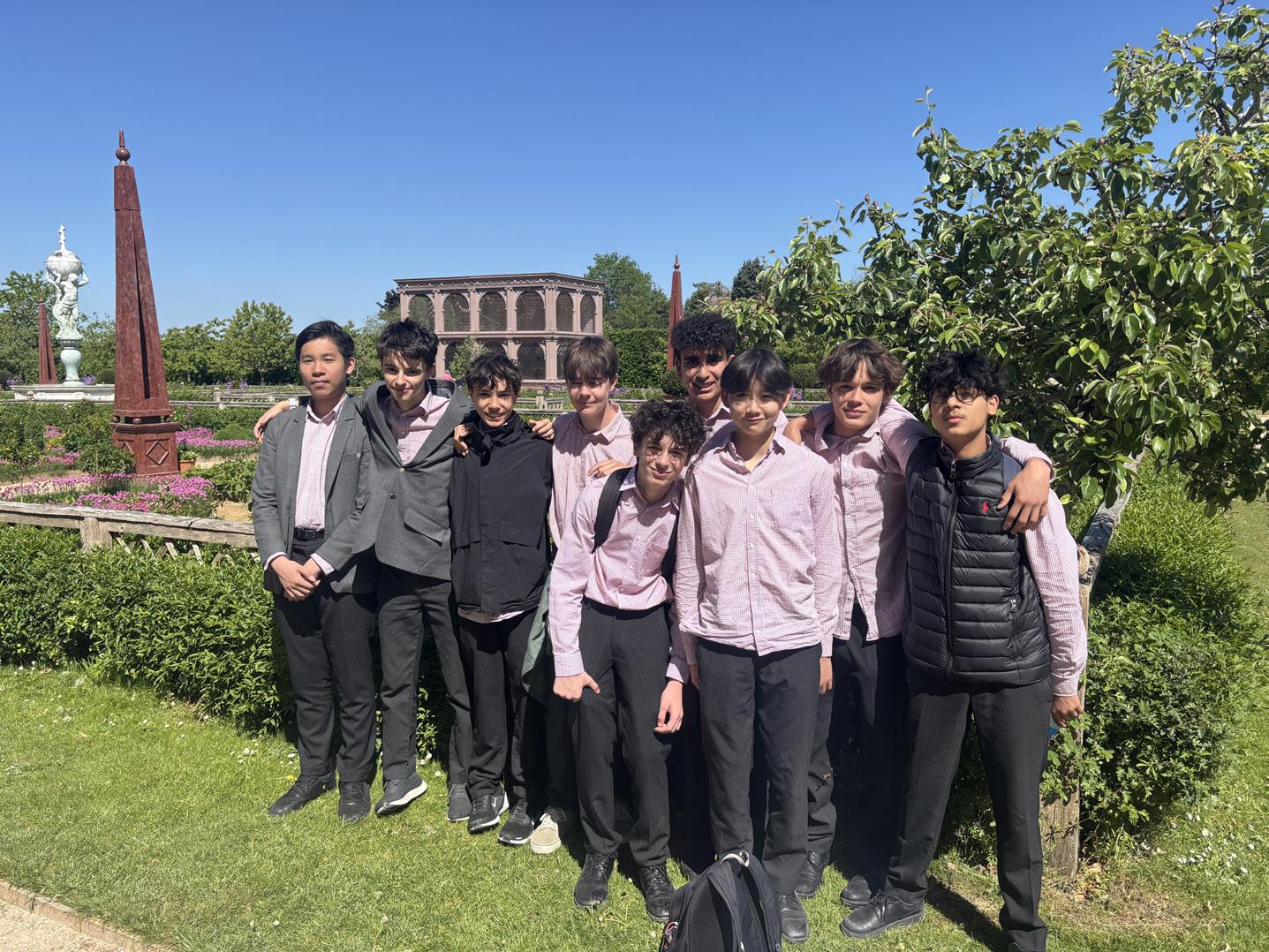
Alex W-P, Year 8 writes...
On our Year 8 end-of-year trip, we went to Hampton Court Palace with the history department. For those who don’t know, Hampton Court Palace is a royal palace located in Richmond upon Thames. It was originally built for Cardinal Wolsey, but later taken by Henry VIII with or without Wolsey’s permission.
We set off from school at 8:10 and arrived 1 hour and 10 minutes later at 9:20. We were led by Mr Barnett to the replica wine fountain, which was once commissioned by Henry VIII to circulate wine. Then we were shown Anne Boleyn’s room, where she had a secret door leading to a new section in her apartment so that when Henry’s guards stormed up the stairs, she could escape.
We also saw the room where Elizabeth I was looked after as a child, more specifically when Elizabeth got smallpox. Everyone was terrified to be around her since smallpox was contagious, but Sybil Penn was the only one who would care for her. She
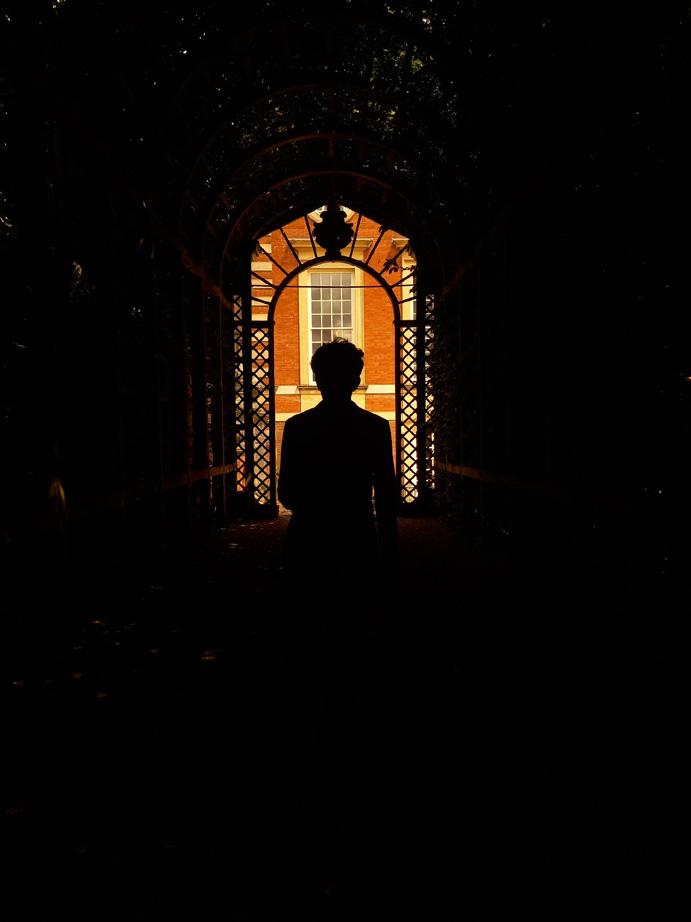
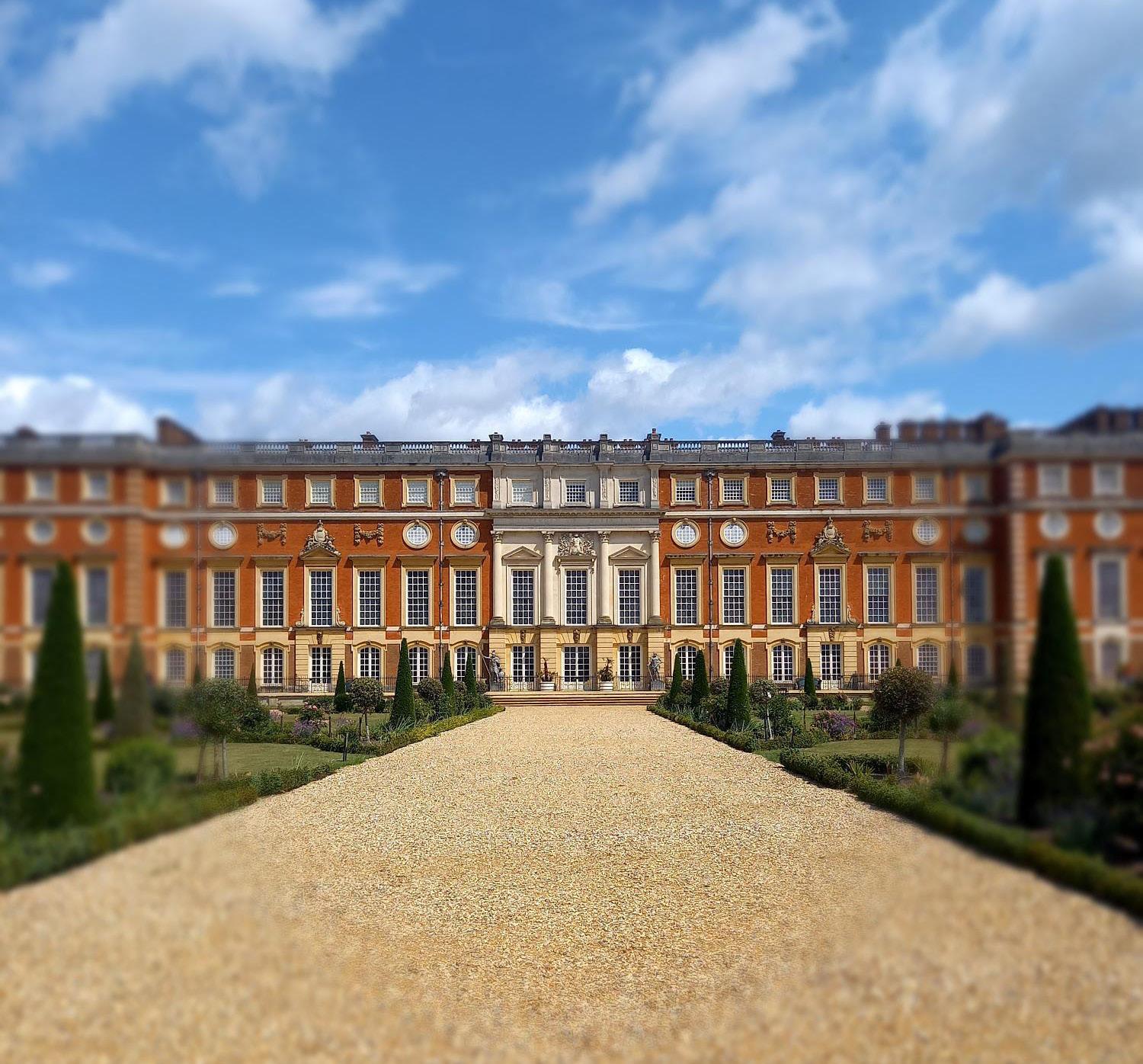
would spin string on her spinning wheel and sing songs, but sadly, as a result, Sybil was infected and passed away. Many years later, a resident heard an irritating noise in the walls. At first, they thought it was created by a family of mice, but upon inspection of multiple layers of wooden wall insulation, Sybil Penn’s spinning wheel was found.
One more exciting story that happened at Hampton Court Palace involved one of our year’s most important figures in history: Charles I. In August 1647, Charles was imprisoned at Hampton Court Palace. He was given one hour every day by himself in his study to work and write letters. One day, he asked his servant if he could have three hours instead of the usual one hour, and his servant agreed. A few weeks earlier, Charles had written to the Scottish Royalist Party that he
was planning an escape and for them to meet him when he did. So, during his extended session, Charles escaped to meet the Scottish and galloped away on his horse.
Towards the end of our trip, we ventured into the Great Fountain Garden, where we crowded around the fish in the Great Fountain and ran through the hedge tunnel. After lunch, we had a lengthy walk getting lost in the maze (which is seen as one of the hardest mazes in England) and were misled by the teachers about what we had to find. Our last stops at Hampton Court Palace were Henry’s private chapel, which is still in use today, the grand kitchens (which were as big as our school), and finally the Great Hall.
Overall, I think it was a great day out, and I believe on behalf of my year that we all had a great time.
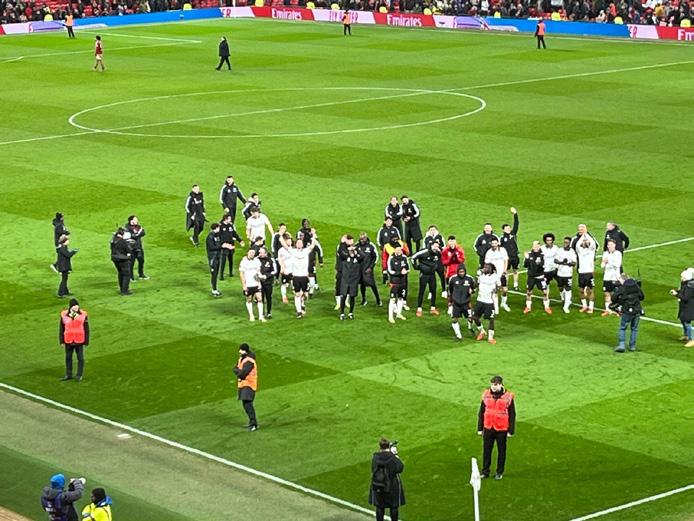
Henry C, Year 7 writes...
This season, I have been very lucky to have gone to ten away games with my team, Fulham FC — both Premier League and Cup fixtures — that I would like to share with you.
First off was playing Ipswich Town. This was their second home game of the season and their second in the Premier League in twenty-two years after being stuck in the lower divisions of English football. When we arrived, a short distance from the train station, we strolled around the stadium and saw a statue of Bobby Robson, who played for us in 1950–1956 and 1962–1967 and later managed us briefly in the 1968/69 season. He went on to manage Ipswich for thirteen years, winning two major trophies: the FA Cup (1977–78) and the UEFA Cup (1980–81). The game ended 1-1, with the Fulham goal scorer being Adama Traore.
My second away game of the season was Nottingham Forest. We had high hopes for this game as the season before they’d finished seventeenth, and we saw Fulham beat them 5-0 at The Cottage late in 2023. Since this was only September, little did we know they would play some of the best football in the league
this season, finishing seventh but spending most of the season between third and sixth. I can assure you this game was a lot more even than the previous one, finishing 1-0 to Fulham with a Raul Jimenez penalty and a clean sheet for Bernd Leno, our keeper.
Next, we travelled not too far to South London to meet this year’s FA Cup champions, Crystal Palace, though we didn’t know it yet! London’s Originals were very lucky to play The Eagles early in the season, as they had a brilliant last ten or so games! We comfortably beat them 2-0 with goals from Emile Smith Rowe (ESR) right before the half-time whistle and the Welsh wizard Harry Wilson late on as he came on as a substitute, as well as two offside goals from the same players. Crystal Palace also had a player sent off for a nasty tackle! Great result there!
Fourthly, we have Spurs! Tottenham didn’t have the best season, finishing seventeenth, but they did win the Europa League — their first trophy in seventeen years! Again, this away game was in North London, so not too far to travel. Spurs recently built a new stadium, Tottenham Hotspur


Stadium, which was very nice! Annoyingly, this game ended 1-1, which seemed like an OK result at the time, but looking back we could’ve, and should’ve, won because we beat them 2-0 at The Cottage in March! A brilliant goal in the 76th minute from the club captain Tom Cairney levelled it just before he was handed an undeserved red card.
Next on the list is Chelsea away at Stamford Bridge — the only away game me, my brother, and dad could walk to because the grounds are so close together! Fulham don’t like The Blues because we are local rivals, so the players were probably really motivated. This game fell on Boxing Day, and it was the perfect and historic Boxing Day present! Great limbs from the Fulham fans and hardly any from the Chelsea fans, as always! Chelsea scored quite early on but, of course, the Blues fans hardly celebrated. The players went into half-time and our manager, Marco Silva, must

have given a great team talk. In the 74th minute Harry Wilson came on as a sub and scored! Then, in the 95th minute of stoppage time, Rodrigo Muniz slotted it home to win it for us — historically our first win there in 45 years! Best atmosphere at a football match I’ve ever been involved in! Brilliant scenes.
Next up we travelled to Leicester to watch The Whites comfortably beat them 2-0 — goals from ESR and Adama Traore! Not much of a flex though, as The Foxes were very mediocre this season, only scoring 33 goals, second lowest in the Prem after Southampton! They
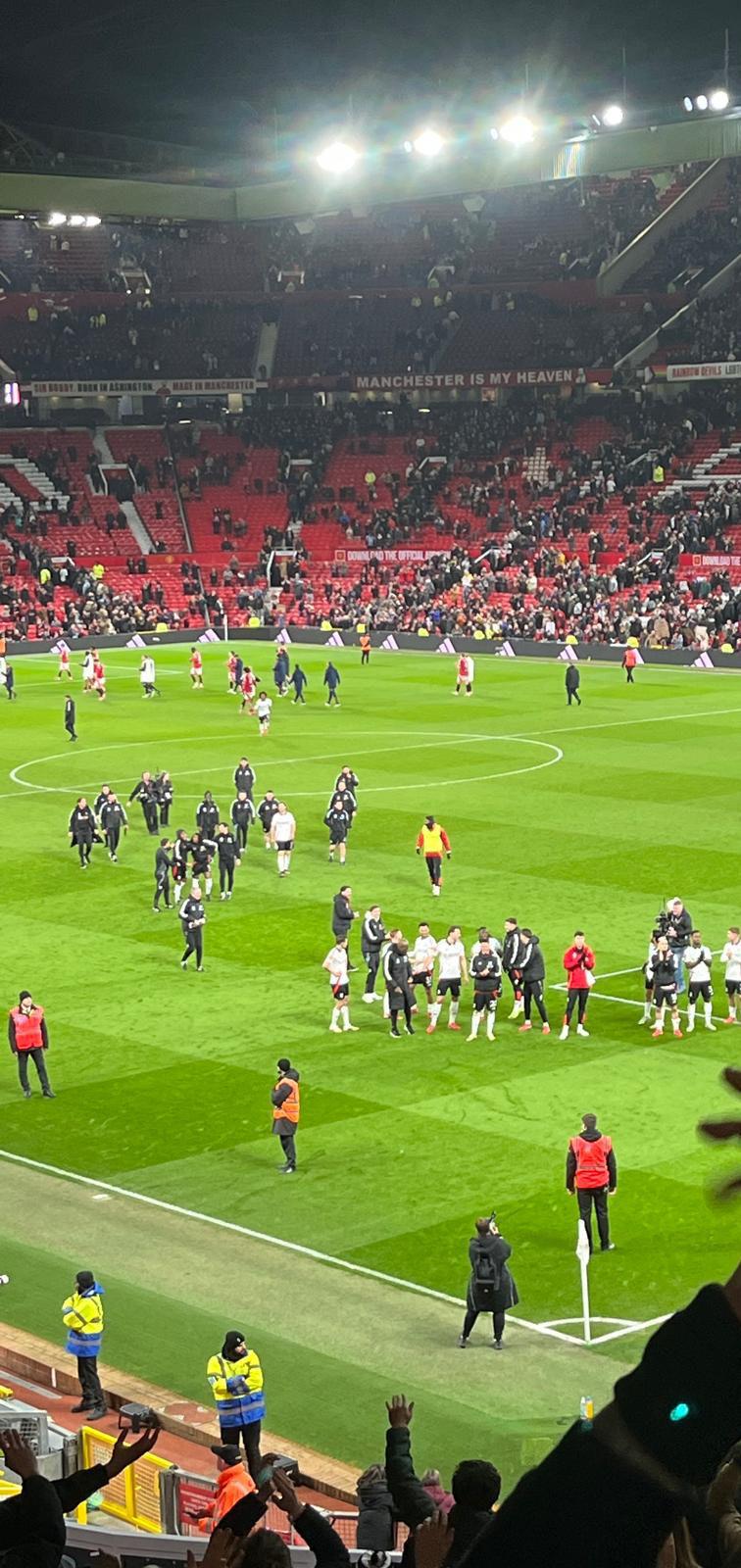
also finished nineteenth out of twenty teams. Easy win!
After that our travels took us to the north of England to play Wigan in the FA Cup in the fourth round. We beat The Pies 2-1, with a brace coming from the Brazilian Rodrigo Muniz, Samba style! The only good thing from Wigan was a very good goal from outside the box.
My eighth away game of the season was Man United at Old Trafford in the quarter-final of the FA Cup. Seeing Old Trafford in person was amazing — I had heard a lot about it and it’s a great stadium. The Red Devils had their worst season in a long, long time, finishing 15th, their worst Premier League position. This game ended 1-1 at full time, with the Fulham goal scorer being Calvin Bassey. Then Fulham beat them on penalties 5-3, with our goalie Bernd Leno being the hero, saving Joshua Zirkzee’s penalty to win. Pure emotion!
The highlight of my next away game, Brighton v FFC, was that my dad completed a bike ride for the Fulham Foundation from Craven Cottage to the Brighton Stadium the day before. Brighton fans are very unlucky going to the Amex every home match — very plastic and out of town so difficult to get to easily. The game finished 2-1 to Brighton, with the Fulham goal scorer being Raul Jimenez.
Next up we travelled to North London to face Arsenal. The match ended 2-1 to The Gunners. This game had a fantastic atmosphere — unlike usual at The Emirates!
My final away game was at Southampton. They already knew
they were going to be relegated, with the second worst ever Premier League performance and having scored the lowest number of Premier League goals in a season. We told them to say hello to QPR, another rubbish local rival who we don’t play often since they’re always in the lower leagues. As predicted, Fulham won with a goal from ESR in the 73rd minute and a goal from Ryan Sessegnon, who graduated from our Academy a few years ago, in the 96th minute. Brilliant atmosphere — not from the Southampton fans though!
I would definitely recommend, if you’re into football, trying to go to at least one away game for your club. They’re really great fun and a wonderful way to tour the country, soak in a bit of local culture, and enjoy some football — especially with a family member; I go with my dad, my brother, and sometimes my mum tags along!

Thomas C, Year 9 writes...
When I first saw Sumo wrestling, I thought it was just two huge guys bumping into each other until one fell down. But then I started learning more about it, and now I think it’s one of the coolest and most interesting sports out there. Sumo has an incredible history, unique rules, exciting tournaments, and some real-life legends. If you think Sumo is boring, you’re totally wrong — it’s intense, respectful, and full of tradition.
The History of Sumo Sumo wrestling started over 1,500 years ago in Japan. Back then, it wasn’t just a sport — it was part of a religious ceremony to honour the Shinto gods. People believed the gods would bless their land and crops if the Sumo matches were performed correctly. Eventually, Sumo became popular entertainment and turned into the professional sport we know today. Even though it’s now a sport, Sumo still keeps many of its ancient traditions. Before each match, the wrestlers clap their hands, stomp their feet, and throw salt into the ring to purify it. That’s all part of its rich history.
The Rules of Sumo Sumo rules are simple, but the techniques can be very advanced. Two wrestlers (called rikishi) face off in a circular ring called the dohyō. The goal is to either push your opponent out of the ring or make him touch the ground with any part of his body other than his feet. You can push, slap, trip, and throw — but no punching, hair pulling, or choking. The matches are super fast — sometimes they
last only a few seconds! But even though they’re short, each one is full of strategy and power.
In professional Sumo, there are six divisions. The lowest is jonokuchi, where beginners start. After that comes jonidan, sandanme, makushita, jūryō, and the highest, makuuchi. Only the top two divisions (jūryō and makuuchi) are considered full-time professional ranks, and wrestlers in these divisions get paid salaries. The makuuchi division is where the top-ranked rikishi compete, including the yokozuna. Wrestlers fight hard to climb the ranks and reach makuuchi, but it takes years of dedication. The higher you go, the tougher the competition gets.
How Tournaments Work
There are six major Sumo tournaments in Japan each year. They last 15 days, and each wrestler fights once a day. If a wrestler gets a winning record (called kachi-koshi, meaning 8 wins or more), he can move up in the rankings. If he loses more than he wins (make-koshi), he moves down. The top rank in Sumo is called yokozuna. It’s incredibly hard to become a yokozuna — you have to win multiple tournaments in a row and show dignity and strength. Only the best of the best make it.
The Legends of Sumo Sumo has had many famous wrestlers over the years. Names like Taiho, Chiyonofuji, and Akebono are remembered as some of the best. These guys weren’t just strong — they were skilled and respected by fans and fellow
wrestlers. Being a Sumo legend means more than just winning — it means showing honour, discipline, and leadership.
The Career of Hakuho Sho Hakuho Sho is considered the greatest Sumo wrestler of all time. He was born in Mongolia and moved to Japan to train. He became a yokozuna and went on to win a record 45 tournaments — more than anyone else in history! He was fast, smart, and strong. He stayed at the top for over a decade. Even when he was injured, he still managed to win. He retired in 2021 and is now training the next generation of Sumo stars.
Sumo wrestling is way more than it looks. It’s not just pushing and shoving — it’s a sport full of history, skill, and respect. The rules and traditions make it special, the tournaments are exciting, and legends like Hakuho Sho prove how awesome Sumo really is. Now I see why so many people in Japan (and around the world) love it. I definitely want to keep learning more about it.

Luke T, Year 10 writes...
On Thursday 22nd May, Wetherby Senior School entered the ISA Track Regionals. Fifteen boys from Years 7 to 10 competed across the junior, intermediate and senior boys’ categories, and we had one of our most successful years to date. Several boys performed brilliantly, and some even qualified for the nationals.
Owen McDonald came 2nd in
his Year 7 100m heat. Riyadh came 3rd in the high jump, clearing 1.40m, just missing out on nationals in the intermediate boys’ category. Zain came 2nd in the 1500m, and Nathan came 1st in the 800m, both in Year 9. Unfortunately, neither can go to nationals as they will be on the music trip when the nationals take place in Birmingham. Ivan, also in Year 9, came 3rd overall in the 200m, narrowly missing out on nationals.
For the senior boys, Orland qualified with an impressive winning throw in the shot put. I was delighted to secure a win in the 1500m and will also be heading to nationals.
Overall, it was a very successful trip, and I’m sure all the boys who competed enjoyed it — even those who just missed out on qualification for the next round.

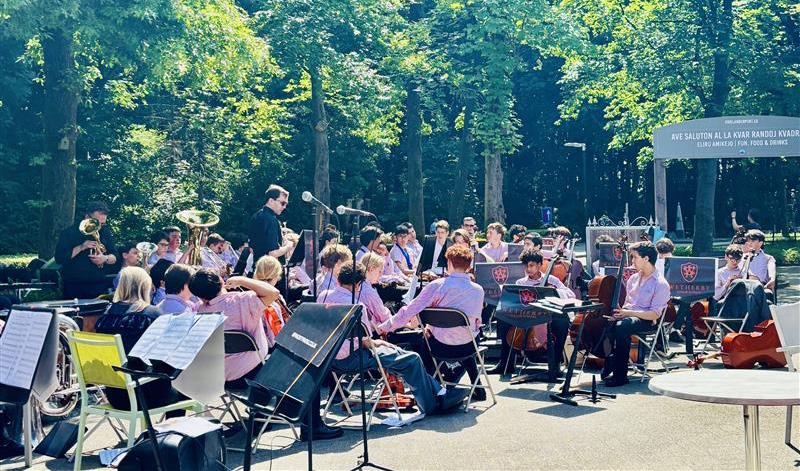
Felix W, Year 12 writes... After months of rehearsals, excitement and anticipation, this year’s Music Tour saw six of our best ensembles — Jazz Band, Concert Band, Orchestra, Ten Piece, Senior Brass and Cantamus — take to the road (and rail) for an unforgettable week in the Netherlands, Belgium, France and Germany.
Setting off early from Marylebone, we loaded up our instruments and boarded the coach, which rolled straight onto the train at the Eurotunnel in Folkestone. A quick stop in Calais and a scenic drive later, we found ourselves in Valkenburg, a beautiful Dutch village that we would call home for the next four days.
Day two kicked off with a trip to the Drielandenpunt, the point where the borders of the Netherlands, Belgium and Germany meet. We set up and performed in front of crowds that stopped by to listen — our music quite literally transcended borders and rang out to audiences in three separate countries (quite a bizarre realisation!). After our performance, we enjoyed the attractions on the Dutch side, with the labyrinth in particular becoming a fan favourite.
The afternoon of day two was packed with sightseeing. A guided tour of Valkenburg’s castle ruins
and adjoining caves gave us a glimpse into the town’s fascinating past. The caves beneath the castle served both as a source of sandstone for building material and as a sanctuary for Catholics during the French occupation in the 1700s, and later as a refuge for Dutch resistance fighters in the 1940s.
We ended the day on a high (pun intended), chairlifting up to the Wilhelmina Tower and racing (or in some cases, gently cruising) down the hill on toboggans. Honourable mention goes to the staff members who decided that braking was the better part of valour!
Day three took us across the border into Germany for an adrenaline-filled outing at Phantasialand, one of Europe’s most famous theme parks. With towering rollercoasters and plenty of churros, it was a brilliant and unforgettable way to let off some steam. That evening, back at the hotel, we performed our final concert — a fitting finale to a trip
none of us wanted to end.
All of us who went on tour owe a massive debt of gratitude to the Music Department for all the support they’ve given us — not only during the tour, but week in, week out through instrumental lessons and ensemble clubs. A huge thank you to Mr Lewis for his phenomenal conducting; Mr Wilsher for brilliantly leading the woodwind section; Ms Gorbanova and Ms Lee for directing the strings; Mr Budd and Mr Dean for ensuring the brass section always rang out the loudest; and last but by no means least, Mr Martin for organising the entire tour!
Mr Lewis says: “The 2025 tour was our biggest yet and, judging by the response from our audiences, definitely the best! The activities were as fun as ever, but for me the real highlight was seeing so many of our boys working so hard for each other to ensure the success of each performance. With nearly 70 musicians on stage for both concerts, music stands needed

sharing around the different groups, and several of our boys were also involved in multiple groups on different instruments. The team ethos we have been working to instil was in clear evidence as we overcame these potential challenges: boys warmly applauding the efforts of their peers, helping to move chairs, stands, music and instruments, and even holding music down for each other against the warm summer breezes! We’re all exhausted, but after the success of this year we are already looking forward to our next tour.”
Mr Martin adds:
“It’s hard to pick highlights out of so many positives, but it was great to see so many boys involved in this year’s tour and enjoying new experiences. Our older boys were a credit to themselves, acting as positive role models for the younger students with their helpfulness and positivity throughout. Members of Cantamus, our choral group on their first school tour, earned some of the loudest cheers for their performances of Paul Barker’s

Roquiem, while the Concert Band and Orchestra impressed audiences with renditions of Call Me Maybe, The Mandalorian, Sibelius’ Finlandia and Howard Shore’s Lord of the Rings: The Fellowship of the Ring. Mr Lewis’ brass ensemble arrangements of The Godfather and classic pop tunes Celebration and September proved as popular as ever, and audiences were also treated to typically classy performances from our Jazz Band. In our 10th
Anniversary Year, it is amazing to reflect on how far we have come since the earliest days when Mr Lewis and I first discussed ideas for developing ensemble music and launching our first tour in 2018. We look forward to many more exciting opportunities in the years to come.”
Overall, this year’s tour was a great success — bring on next year!
Daniel L, Year 12 writes...
On Saturday 7th June 2025, 115 young chess players gathered for the UK Chess Challenge London Megafinal — a key stage in one of the country’s largest junior chess competitions. This year, the event was hosted at Wetherby Senior School.
The day featured six rounds of matches, with competitors facing a range of opponents from top regional clubs and schools. One
Wetherby student, Algernon Delaney, faced strong opposition throughout the day and gained valuable experience at the event, finishing with a performance rating of 892.
Although challenging, the event was a great opportunity for young players to test their skills, build confidence, and represent their schools. All participants showed great focus, resilience, and sportsmanship throughout the day.

In this position from the weekend white resigned, but actually is winning. Can you find the move?
Brady F, Year 7 writes...
Before the trip:
I thought it would be a fun trip, with exciting rides and interesting places to see. I had looked at the advert a few times when I was watching TV, and the rides seemed good — although part of me felt a tiny bit underwhelmed. But I didn’t know if that was fair, because I had never been there before. I’d heard there was a zoo with animals like giraffes, but I wasn’t sure about that either. Chessington is quite far from London, which I thought might affect how much time we’d have to spend there.
After the trip:
Chessington World of Adventures was about a one-hour journey, and surprisingly the trip there flew by. We were sorted into groups
(which we got to choose ourselves), and when we were finally let off, I was very excited. Although we didn’t know where all the rides were, we found one — but the queue was really long. Half my group wanted to do a football game, but my friend and I didn’t, so we went off to the World of Jumanji Ostrich Stampede. There was no queue — we only waited about five minutes — and when we got on, it was super fun.
Next, we headed to Mandrill Mayhem. It looked really fun and scary, but the queue was long. Annoyingly, I was so close to getting on when it stopped due to cleaning. Even more annoyingly, I had to leave the queue and felt like I’d wasted all that time. And, even more annoying — just as I left, the ride started again!
To make up for it, I went on Tiger Rock where I rode a boat and went down a huge chute twice — I got very wet!
Then it was lunchtime. I went to the Smokehouse Bar & Grill, where I bought a pizza (which was very expensive at £15.50) and shared some with my friends.
After lunch, my whole group went on the pirate ship, which was surprisingly more fun than we expected. Then we went on Tiger Rock again together, and it was really fun. Later, I managed to go on Mandrill Mayhem by myself — it was really scary at first, but later I found it fun.
Finally, everyone visited the gift shop and bought something, and then we got on the bus to head back to school.
My rating of the trip: 8.7/10.


Charlie D, Year 12 writes...
Have you ever wanted to be the hero in a fantastical story — slaying dragons, casting magical spells, and embarking on legendary quests to be sung about in taverns across the land and throughout the ages?
Well, let me introduce you to the next best thing: the Dungeons & Dragons (D&D) Club.
The club revolves around D&D — the most popular tabletop roleplaying game (TTRPG).
But what is a TTRPG?
Glad you asked. It’s where you and your companions create and roleplay your own characters to forge epic adventures using nothing but pen, paper, and a whole lot of dice.
With a little bit of maths, creativity, and elbow grease, you can build your characters in many
different classes — like Wizards, Warlocks, and Clerics — and species, such as Elves, Goliaths, and Dragonborn.
Or, if you prefer, you can take up the mantle of Dungeon Master (DM) — the omnipotent narrator who crafts the world and story, and tries to keep the players (mostly) on track.
Whether you’re here for the magic, the maths, or the friends we make
along the way, the D&D Club is a brilliant way to break into the fantastic world of TTRPGs.
If this sparks your interest, please drop by our weekly meeting during Friday lunchtime. We cover the basics of character creation, world-building, and everything else you need to start your quest.
Nothing but a pen and your imagination required!

Dylan S, Year 9 writes...
You have probably already played classic board games such as Cluedo or Monopoly, but I am here to tell you that there is more out there than just the conventional board games. There are many new and, in my opinion, better options. There has been a huge change in the way board games are designed. You’ve all been there—having to leave a game of Monopoly because it was your bedtime. However, modern board games such as Carcassonne are designed not to outstay their welcome. For example, in Carcassonne there are always 84 turns, or in Ticket to Ride the game ends when someone runs out of trains to place. So it’s reliable—you can fit in a game and still make it to the art gallery opening before the hors d’oeuvres run out.
I don’t know what you do with your evening, but I’m sure you don’t have an infinite amount of time to play. In modern board games, they value the time you spend playing as they make sure each turn is as entertaining as possible. In Cluedo, you can easily spend a turn doing nothing as you make your way to a room. While in Pandemic, there is always something to be done, and
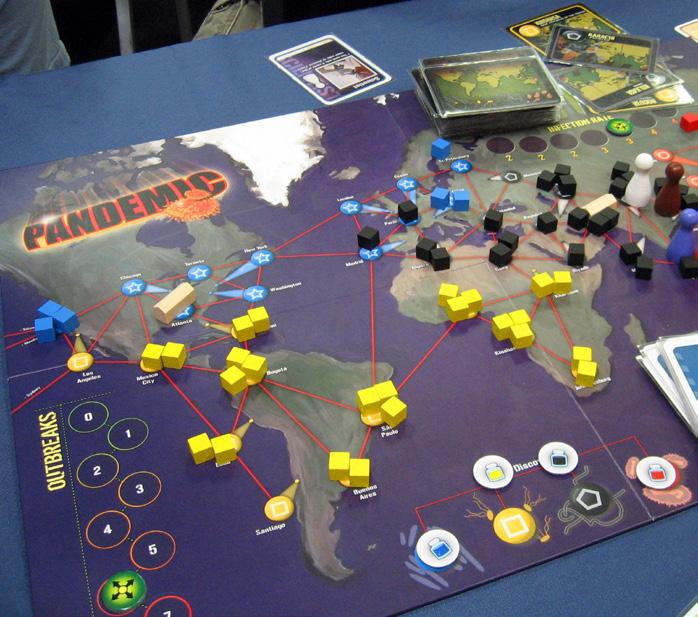
everybody can contribute—no one’s productivity is governed by a roll of the dice. Or in Monopoly, where it’s even worse, as you can be put in prison and miss an entire turn. The most boring part of playing a board game is when you’re not even playing—and older games seem obsessed with this.
This is not to say that modern board games aren’t punishing. Take High Society, where you play a rich socialite splashing cash on luxury items to get the most points—yet the catch is that if you’ve spent the most money at the end of the game, you can’t win. The game punishes you for your actions or decisions rather than randomly sending you to prison like in Monopoly. Or in Heat: Pedal to the Metal, where you make gambles to go faster but risk your engine overheating and causing a spin-out. This is much better than being punished because of a roll of the dice— you have more control over the consequences in the game.
Imagine you’re at board game night, and on the first turn you’re removed from the game and stuck awkwardly sitting while your friends have fun. This happens in games like Werewolf, where every round two players get kicked out. This is called player elimination, and modern board games avoid it while keeping the hidden traitor mechanic. In The Resistance, for example, instead of killing the other players, the traitor sabotages missions—so you still get the fun of trying to convince your friends of your loyalty or being the next Sherlock Holmes, yet no one gets left out.

It’s really demeaning to play a board game where you feel like you have no chance of winning— as you would know if you’ve ever played against a very good Scrabble player, that feeling of being a hundred points behind. Yet modern board games save you from this embarrassment in a few ways. In The Quacks of Quedlinburg, where you’re trying to fill a magic cauldron with different tokens, they stop players from getting too far ahead by giving you a head start in the next round if you were behind, preventing a cumulative winning effect and giving you a reason to keep playing. While in Monopoly, where the rich keep getting richer just due to early luck, a losing player feels like there’s no chance of catching up (and yes, I know this is intentional—but that doesn’t make it fun; if you love the accuracy so much, just go read an economics textbook).
Modern board games make sure players feel they can win at any point, even if that’s not actually true. They intentionally keep the points hazy, using end-of-game triggers—such as in Ticket to Ride, where you only reveal your goals at the end so you don’t know how many points other players have. Even if you’re miles behind, you’d be oblivious, and as the famous idiom states, “ignorance is bliss.” It keeps players more motivated to continue.
In modern board games, you feel more in control as it’s less based on luck. Unlike Monopoly, where you roll the dice and get only two decisions—one of which is doing nothing (like your parents cooking you dinner and you can either eat it or go hungry)—modern board games hand you a menu full of delicious options that are impossible to choose between. In Cascadia, you’re building a North American wilderness reserve and filling it with wildlife. Each turn, you pick from four options and then decide where to place the new tile. So there are 100 ways to take your turn, but it’s never overwhelming. It’s like going to a restaurant where you had something in mind before you saw the menu—if you’re in the mood for fish, you choose the salmon.
This is not to say that luck is bad—it’s just how luck is used. In the zombie apocalypse game Dead of Winter, you roll dice and then work out how to spend your points in exchange for actions. If you roll lower numbers, you might not be able to kill zombies, but at least you know about it in advance and can plan, rather than wasting an action because luck wasn’t on your side. You can still
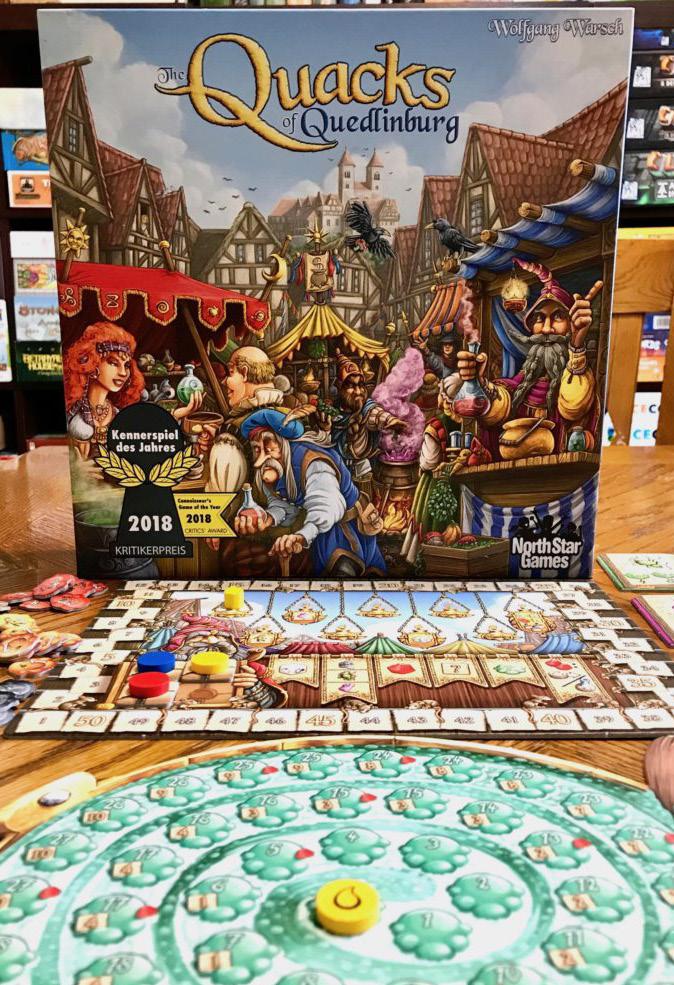

do something else, such as search for food or take part in group story cards where you must react to events.
In Risk, a game meant to be about military strategy, battles often come down to a roll of the dice, as in many older board games. Monopoly and Risk are both aggressive games where you tear your neighbour down to win—winning isn’t enough; your opponent must become bankrupt or have all their pieces wiped off the board. This isn’t exactly conducive to a pleasant Sunday with family and friends. In modern board games, while still competitive, you can’t swoop in and destroy your fellow players’ hard work. You might steal points they were hoping to achieve—like taking the last slice of cake rather than throwing it in your friend’s face. In Ticket to Ride, your train route might ruin someone’s plans, but it wasn’t intentional. You’re all fighting for the same space, and you might not have even known they wanted it—your focus is getting the most points for yourself, like an actor trying to get all the roles they can. This might hurt other actors, but they don’t do it to spite them. So your efforts in the game aren’t wasted by someone else destroying them, making you question why you bothered in the first place.
Some games take this even further by giving you your own personal bubble to play in. In Sagrada, you build a stained-glass window by
arranging coloured dice on your personal board in a delicate puzzle that requires planning. It wouldn’t work if other players could interfere, and even if you fail, you still feel accomplished having built something in front of your eyes. It may not be on any great cathedral, but it’s your own piece of art.
There are thousands of great modern board games, not only the ones I’ve mentioned here, for you to choose from. No matter which mechanic or setting you prefer— you can go from a great twoplayer game like Watergate (where you choose to be Nixon or the journalists from The Washington Post), to being a NASA scientist in Terraforming Mars, to being in a horror film in Betrayal at House on the Hill. With modern board games you can have fun being whoever you want to be, wherever you like. I highly recommend looking into the board games I’ve mentioned if they sounded interesting. I hope I’ve inspired more people to explore this amazing hobby.
Thanks to Actualol, a board game YouTuber I highly recommend, for inspiring me to write this article and get into the hobby in the first place.

Felipe E, Year 10 writes...
As a Year 10, once you finish the penultimate half-term of the year, you gain many privileges. Two of the main ones are that you no longer need to have your phone locked in your Yondr pouch every day and that you can head out for lunch in the local Marylebone area—with strict limits on where you can go, of course!
Some great deals in the local area include Wetherby household favourite Tommi’s. They are currently running a deal called Tommi’s Tuesday, where you can buy a burger, fries and a drink for £15.00. Older Wetherby students will remember that you used to be able to get the same thing for £7.90! Another favourite is Bonne Bouche, who offer great sandwiches at affordable prices and sell delicious slices of pizza for £4.50. There is also, of course, Pret A Manger, with three locations close to school offering good sandwiches and hot food. Paul runs a nice sandwich spread at lunchtime, especially their brilliant sandwich mixte. Magnum News is also a Wetherby institution—less known for its hot food, but with a great range of snacks and drinks from around the world that can be bought at reasonable prices.
In conclusion, if you’re looking for something reliable, Pret is probably your choice. But Paul is the place to go if you want a nice sandwich and pastry. Tommi’s is the obvious choice for great burgers and deals, with fast service too! Magnum News is probably more of an option for breaktime, but remains a solid choice.




BenG G, Year 9 writes...
Cheese originated over 7,000 years ago, and the cheese-making process and preservation may have begun with the pressing and salting of curdled milk. Animal skins and inflated internal organs already provided storage vessels for a range of foodstuffs. Curdling milk in an animal’s stomach produced solid and better-textured curds, which could easily have led to the conscious addition of rennet (a complex set of enzymes produced in the stomachs of mammals).
Hard, salted cheese like Parmigiano Reggiano is likely to have accompanied dairying from the outset, as it is the only form in which milk can be kept in a hot climate. The earliest written evidence of cheese is found in Sumerian cuneiform texts of the Third Dynasty of Ur, dated to the early second millennium BC. The earliest cheeses were sour and salty, similar in texture to rustic cottage cheese or present-day feta. In Late Bronze Age Minoan-Mycenaean Crete, records mention the inventorying of cheese, as well as later Greek flocks and shepherds. The oldest preserved remnants of cheese were identified on mummies in
the Xiaohe Cemetery in presentday Xinjiang. Archaeological evidence for cheese-making in Egypt goes back about 5,000 years. In 2018, archaeologists from Cairo University and the University of Catania reported the discovery of the oldest known cheese from Egypt, found in the Saqqara necropolis and dated to around 3,200 years ago.
Most named cheeses known today were initially recorded in the late Middle Ages. The existence of cheddar has been recorded since the 1500s; the production of Parmigiano Reggiano (not to be confused with Parmesan, which is a different cheese) began in 1597; Gouda in 1697; and Camembert in 1791.
Many cheeses are fine for people who are lactose intolerant, as the process of making cheese removes most of the lactose. For example, Colby, cheddar, and Camembert typically contain 0% to 1.8% lactose. There are many different ways to make cheese, and each method gives the cheese its own unique flavour. For example, cheeses made with rennet are more salty and savoury, whereas those made with bacterial cultures tend to be tangier (it’s even possible to use bacteria from your foot to make cheese!). Soft cheeses like brie are left to ripen for a shorter time, while harder cheeses like cheddar are cured for longer. This affects both the flavour and texture of the final cheese.
Finally, there’s the ageing process. Some cheeses, like Parmigiano Reggiano, are aged for years to develop their complex flavour profile. Others, like Boursault, are only aged for a few weeks. Cow’s milk tends to make harder cheeses, goat’s milk produces something creamier, and sheep’s milk is somewhere in between. You can also use more unusual milks, like hippo milk and others.
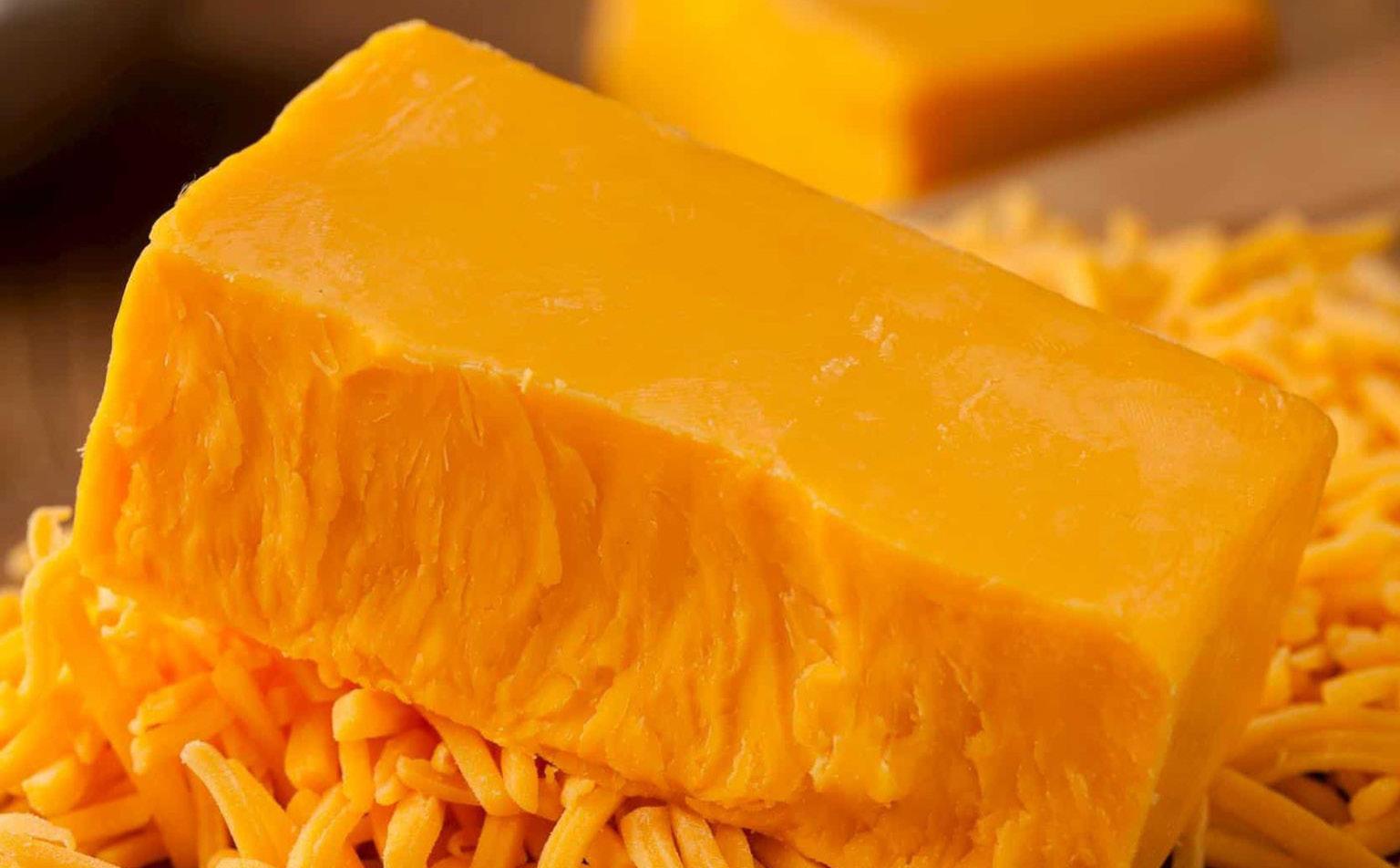
Do you have something you’d like to write about?
Is there a passion or interest you’d like to share with others?
Is there a cause you would like to draw attention to?
Would you like to report on school events?
Are you a great photographer or artist?
Send your articles (and images to go with them) to nicola.bradley@wetherbysenior.co.uk, or ask to be added to the team on Teams where you can submit it directly.
A submission deadline will be set each half term, so get writing so your article can be included!